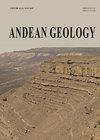Caracterización estructural del sistema de ledges y clavos mineralizados del sector Cachinalito, mina El Guanaco, región de Antofagasta, Chile
IF 1.2
4区 地球科学
Q3 GEOLOGY
引用次数: 0
Abstract
The high sulfidation epithermal gold deposit El Guanaco is located in the Palaeocene-Lower Eocene metallogenic belt in the Antofagasta Region, northern Chile, 215 km SE of Antofagasta city. The deposit is characterized by a system of sub-parallel ledges made of vuggy silica and quartz enargite veins. In the Cachinalito sector, on the north western side of the ore deposit, the ledges system has a discontinuous linear morphology, with a general ENE-OSO orientation, consisting of many ledges segments that change abruptly in orientation, thickness, length and inclination. Grade analysis distribution, detailed mapping at deposit scale, and identification of individual structures (ledges) shows that one of the key factors in deposit genesis is the structural control. The structural analysis allowed visualizing the different segmentations within a general structure, considering the sizes, horizontal and vertical continuity, degree of connection between ledge segments of different orientations, as well as determining the orientations with greater development of mineralized structures. The distribution of the grades allowed to characterize and identify the ore shoots within the ledges, and to interpret the ascending pathways of the mineralizing fluids by dimensioning and separating the high- and low-grade mineralized sectors. This type of analysis and identification represents an important exploration tool and helps exploration and / or production drilling in this type of deposit.智利安托法加斯塔地区米纳·埃尔·瓜纳科(Mina El Guanaco)卡奇纳利托(Cachinalito)矿脉和矿柱系统的结构特征
El Guanaco高硫化超低温热液金矿床位于智利北部安托法加斯塔地区的古新世-下始新世成矿带,距离安托法加斯塔市东南215公里。矿床的特征是由多孔二氧化硅和石英绿柱石脉组成的亚平行岩架系统。在矿床西北侧的Cachinalito区,岩架系统具有不连续的线性形态,具有一般的ENE-OSO方向,由许多岩架段组成,这些岩架段在方向、厚度、长度和倾斜度上突然变化。品位分析分布、矿床规模的详细绘图以及单个结构(岩架)的识别表明,矿床成因的关键因素之一是结构控制。结构分析允许可视化一般结构内的不同分段,考虑尺寸、水平和垂直连续性、不同方向的岩架分段之间的连接程度,以及确定矿化结构更发育的方向。品位的分布可以表征和识别岩架内的矿芽,并通过确定高品位和低品位矿化区段的尺寸和分离来解释矿化流体的上升路径。这种类型的分析和识别是一种重要的勘探工具,有助于在这类矿床中进行勘探和/或生产钻探。
本文章由计算机程序翻译,如有差异,请以英文原文为准。
求助全文
约1分钟内获得全文
求助全文
来源期刊

Andean Geology
地学-地质学
CiteScore
3.90
自引率
0.00%
发文量
17
审稿时长
>12 weeks
期刊介绍:
This journal publishes original and review articles on geology and related sciences, in Spanish or English, in three issues a year (January, May and September). Articles or notes on major topics of broad interest in Earth Sciences dealing with the geology of South and Central America and Antarctica, and particularly of the Andes, are welcomed.
The journal is interested in publishing thematic sets of papers and accepts articles dealing with systematic Paleontology only if their main focus is the chronostratigraphical, paleoecological and/or paleogeographical importance of the taxa described therein.
 求助内容:
求助内容: 应助结果提醒方式:
应助结果提醒方式:


